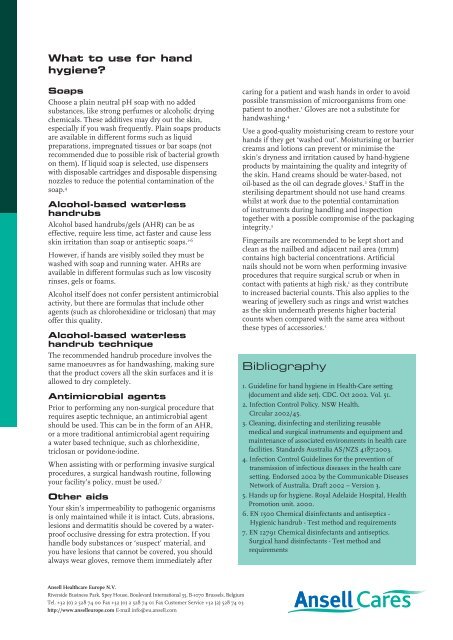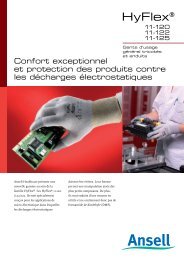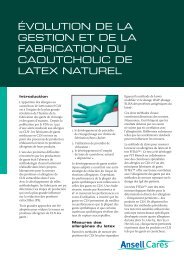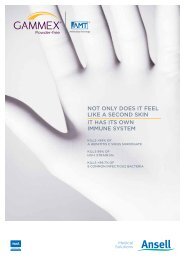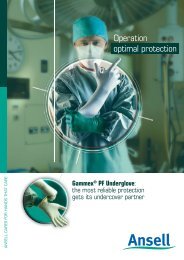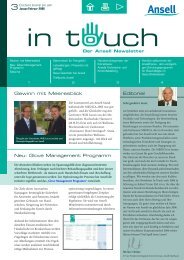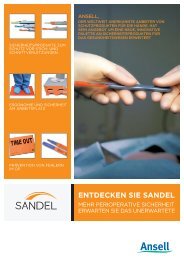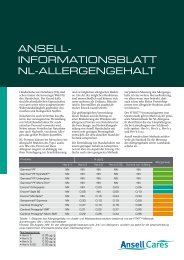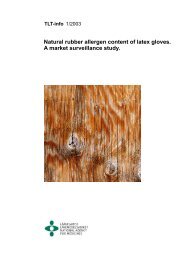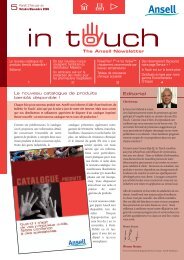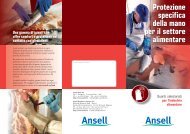importance of hand hygiene - Ansell Healthcare Europe
importance of hand hygiene - Ansell Healthcare Europe
importance of hand hygiene - Ansell Healthcare Europe
You also want an ePaper? Increase the reach of your titles
YUMPU automatically turns print PDFs into web optimized ePapers that Google loves.
What to use for <strong>hand</strong><br />
<strong>hygiene</strong>?<br />
Soaps<br />
Choose a plain neutral pH soap with no added<br />
substances, like strong perfumes or alcoholic drying<br />
chemicals. These additives may dry out the skin,<br />
especially if you wash frequently. Plain soaps products<br />
are available in different forms such as liquid<br />
preparations, impregnated tissues or bar soaps (not<br />
recommended due to possible risk <strong>of</strong> bacterial growth<br />
on them). If liquid soap is selected, use dispensers<br />
with disposable cartridges and disposable dispensing<br />
nozzles to reduce the potential contamination <strong>of</strong> the<br />
soap. 4<br />
Alcohol-based waterless<br />
<strong>hand</strong>rubs<br />
Alcohol based <strong>hand</strong>rubs/gels (AHR) can be as<br />
effective, require less time, act faster and cause less<br />
skin irritation than soap or antiseptic soaps. 1-6<br />
However, if <strong>hand</strong>s are visibly soiled they must be<br />
washed with soap and running water. AHRs are<br />
available in different formulas such as low viscosity<br />
rinses, gels or foams.<br />
Alcohol itself does not confer persistent antimicrobial<br />
activity, but there are formulas that include other<br />
agents (such as chlorohexidine or triclosan) that may<br />
<strong>of</strong>fer this quality.<br />
Alcohol-based waterless<br />
<strong>hand</strong>rub technique<br />
The recommended <strong>hand</strong>rub procedure involves the<br />
same manoeuvres as for <strong>hand</strong>washing, making sure<br />
that the product covers all the skin surfaces and it is<br />
allowed to dry completely.<br />
Antimicrobial agents<br />
Prior to performing any non-surgical procedure that<br />
requires aseptic technique, an antimicrobial agent<br />
should be used. This can be in the form <strong>of</strong> an AHR,<br />
or a more traditional antimicrobial agent requiring<br />
a water based technique, such as chlorhexidine,<br />
triclosan or povidone-iodine.<br />
When assisting with or performing invasive surgical<br />
procedures, a surgical <strong>hand</strong>wash routine, following<br />
your facility’s policy, must be used. 7<br />
Other aids<br />
Your skin’s impermeability to pathogenic organisms<br />
is only maintained while it is intact. Cuts, abrasions,<br />
lesions and dermatitis should be covered by a waterpro<strong>of</strong><br />
occlusive dressing for extra protection. If you<br />
<strong>hand</strong>le body substances or ‘suspect’ material, and<br />
you have lesions that cannot be covered, you should<br />
always wear gloves, remove them immediately after<br />
<strong>Ansell</strong> <strong>Healthcare</strong> <strong>Europe</strong> N.V.<br />
Riverside Business Park, Spey House, Boulevard International 55, B-1070 Brussels, Belgium<br />
Tel. +32 (0) 2 528 74 00 Fax +32 (0) 2 528 74 01 Fax Customer Service +32 (2) 528 74 03<br />
http://www.anselleurope.com E-mail info@eu.ansell.com<br />
caring for a patient and wash <strong>hand</strong>s in order to avoid<br />
possible transmission <strong>of</strong> microorganisms from one<br />
patient to another. 1 Gloves are not a substitute for<br />
<strong>hand</strong>washing. 4<br />
Use a good-quality moisturising cream to restore your<br />
<strong>hand</strong>s if they get ‘washed out’. Moisturising or barrier<br />
creams and lotions can prevent or minimise the<br />
skin’s dryness and irritation caused by <strong>hand</strong>-<strong>hygiene</strong><br />
products by maintaining the quality and integrity <strong>of</strong><br />
the skin. Hand creams should be water-based, not<br />
oil-based as the oil can degrade gloves. 2 Staff in the<br />
sterilising department should not use <strong>hand</strong> creams<br />
whilst at work due to the potential contamination<br />
<strong>of</strong> instruments during <strong>hand</strong>ling and inspection<br />
together with a possible compromise <strong>of</strong> the packaging<br />
integrity. 3<br />
Fingernails are recommended to be kept short and<br />
clean as the nailbed and adjacent nail area (1mm)<br />
contains high bacterial concentrations. Artificial<br />
nails should not be worn when performing invasive<br />
procedures that require surgical scrub or when in<br />
contact with patients at high risk, 1 as they contribute<br />
to increased bacterial counts. This also applies to the<br />
wearing <strong>of</strong> jewellery such as rings and wrist watches<br />
as the skin underneath presents higher bacterial<br />
counts when compared with the same area without<br />
these types <strong>of</strong> accessories. 1<br />
Bibliography<br />
1. Guideline for <strong>hand</strong> <strong>hygiene</strong> in Health-Care setting<br />
(document and slide set). CDC. Oct 2002. Vol. 51.<br />
2. Infection Control Policy. NSW Health.<br />
Circular 2002/45.<br />
3. Cleaning, disinfecting and sterilizing reusable<br />
medical and surgical instruments and equipment and<br />
maintenance <strong>of</strong> associated environments in health care<br />
facilities. Standards Australia AS/NZS 4187:2003.<br />
4. Infection Control Guidelines for the prevention <strong>of</strong><br />
transmission <strong>of</strong> infectious diseases in the health care<br />
setting. Endorsed 2002 by the Communicable Diseases<br />
Network <strong>of</strong> Australia. Draft 2002 – Version 3.<br />
5. Hands up for <strong>hygiene</strong>. Royal Adelaide Hospital, Health<br />
Promotion unit. 2000.<br />
6. EN 1500 Chemical disinfectants and antiseptics -<br />
Hygienic <strong>hand</strong>rub - Test method and requirements<br />
7. EN 12791 Chemical disinfectants and antiseptics.<br />
Surgical <strong>hand</strong> disinfectants - Test method and<br />
requirements


